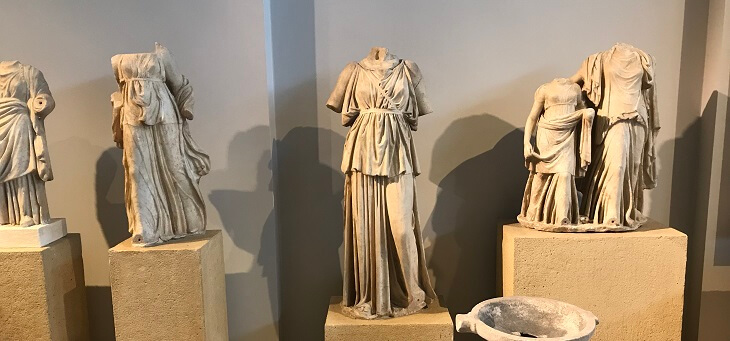What is it about walking around museums that makes me feel overwhelmed, insignificant and tired? On my Greek odyssey, I visited the Archaeological Museum in Thessaloniki in the north of Greece. It is crammed full of ancient Greek and Roman relics, rooms full of statues and plinths and sarcophagi. And gold jewellery to make any Kardashian green with envy. The artefacts are beautifully arranged and, thankfully, alongside the explanation in Greek, they have kindly written a version in English.
I attempt to read everything as I wander slowly from exhibit to exhibit, trying to make sense of the history and join the dots with the loose knowledge I have accumulated. The exhibits explain the history of this area that dates back into the eons of time, thousands of years of history and humanity struggling against the elements. There were Greek artefacts, Roman, Byzantine and Ottoman all leaving their stamp on this part of the world, a veritable melting pot of ideas traded back and forth along the mercantile routes. The artefacts of millions are presented but in some ways the lives of none are shown. How did these people feel, love and live? What have they left behind that will ensure their immortality?
Read: Books to inspire your next holiday destination
As these questions swirled around in my head, my feet began to complain. The hard surfaces and slow pace in the galleries are brutal on an ageing body. But distraction arrived. Not only was I walking on marble floors, there were marble statues everywhere. The statues were stunning, the fold of the fabrics so lifelike that I was envious and overwhelmed all at once. I have tried to go to drawing classes, to shade correctly, to represent cloth on paper and it is bloody hard. Yet here were marble statues that emulate the drape of fabric as if it was child’s play. And they did it in stone, chiselled out of rock, looking effortless and lifelike. Sadly, we have their work to look at but no knowledge of the artists, the true artisans. Did they have any insight as to the future of their work and who would view it down the passage of time?
Room after room was crammed with art. Gold wreaths unearthed from tombs that grave robbers had missed, the gold shining and bright as if forged and created yesterday; small clay animals, some incredibly realistic, no doubt the playthings of children. And then the sarcophagi, bones intact, laid out in the stone coffin, somehow an affront to the dead. They had no say in their afterlife, gawped at by tourists, either dismissed quickly or shuddered at, as we fear our own death ahead.
Read: The best value countries for a holiday this summer
My companion and I, feeling weary and overwhelmed, perhaps also feeling a level of existential angst, then resorted to childish humour, giggling at the small phalluses of some of the statues. A few risqué jokes ensued and the occasional guffaw erupted and was hushed. But we remarked to each other that at least the phalluses hadn’t been chopped off as the ones in the Vatican had, vandalised by some mad cleric, hell-bent on prudish nonsense.
I survived the hours in the museum to happily walk outside and hunt for the best bougatsa in Thessaloniki. After all, there is only so much culture and introspection one can take. Bring on the custard desserts, I say!
Do you enjoy wandering through museums? What’s the best exhibition you’ve visited? Share your opinion in the comments section below.

